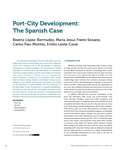Port-City Development: The Spanish Case

Use este enlace para citar
http://hdl.handle.net/2183/25588
Excepto si se señala otra cosa, la licencia del ítem se describe como Atribución-NoComercial-SinDerivadas 4.0 España
Colecciones
- Investigación (FEE) [923]
Metadatos
Mostrar el registro completo del ítemTítulo
Port-City Development: The Spanish CaseAutor(es)
Fecha
2020Cita bibliográfica
López-Bermúdez,B., Freire-Seoane, M.J., Pais-Montes, C., Lesta-Casal, E. (2020). Port-City Development: The Spanish Case. Transactions on Maritime Science, 9(1), 82-89. https://doi.org/10.7225/toms.v09.n01.007
Resumen
[Abstract]: The objective of this paper is to try to evaluate the port-city
relationship from its onset, taking into account the challenges
of port 4.0. Indicators such as the percentage of employees
participating in training programs, the percentage of female
employees in Galician ports, the percentage of merchandise
moved by private operators and the percentage of companies
with quality certification in Galician ports are evaluated. The
fourth revolution is based on the transition from current
fossil fuel-based energy models to alternative energy sources,
changes in the logistics and transport parameters and finally,
on the elimination of intermediation. The key component of
the third pillar of new Economy 4.0 is complete digitalization.
The optimum port-city solution must address the need of both
the urban planner and the port manager to evaluate potential
measures that would alleviate the pressure of dedicated port
facilities on the city and vice versa to the greatest extent possible.
Palabras clave
Port-city
Port 4.0
Automatization
Sustainability
Port 4.0
Automatization
Sustainability
Versión del editor
Derechos
Atribución-NoComercial-SinDerivadas 4.0 España






